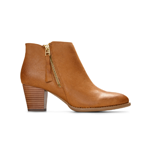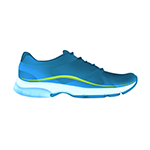
Best Shoes for Arthritis Relief and Comfort

Have you stopped to consider how amazing your feet are?
With upwards of 30 joint connections, 26 individual bones, and over 100 tendons, muscles, and ligaments interconnected, our feet are a true, well, feat of evolution and biomechanics.
Given how complicated this system is, it’s no wonder people ask the question, “can you get arthritis in your feet?” In fact, about 53 million adults in the U.S. struggle with arthritis, and one in six people over the age of 50 suffer from osteoarthritis in their feet and ankle joints.
Though common, there are a few ways you can manage arthritis in your feet, including through arthritic exercises, arch support shoes for women, and arch support shoes for men. In this article, we’ll explore the common causes and symptoms of arthritis, how a well-designed orthopedic shoe can provide relief, and how to pick the best shoes for arthritic feet.
What is Arthritis?
Arthritis is a general term used to describe chronic joint inflammation. It can strike any joint, from the vertebra in the back to the knuckles and elbows. Whether due to an injury, age, or another disease, arthritis eventually breaks down the tissue between the joints. Common symptoms of arthritis include pain, swelling, stiffness, and reduced mobility of the affected joint. It can even cause joint deformity, especially in the big toe joint.
Types of Arthritis
Over 100 different diseases fall under the category of arthritis. Some of the most common include:
- Osteoarthritis – This type of arthritis describes the slow breakdown of cartilage between joints, usually due to age and general wear and tear. As the cartilage disappears, it narrows the space between the joints and can eventually cause the bones to rub against each other. It most often affects the metatarsophalangeal joint connecting your big toe and foot, the midfoot, or the ankle.
- Rheumatoid arthritis – This type of arthritis is an auto-immune disease in which the immune system attacks the tissue lining of the joints. Rheumatoid arthritis can also attack the bursae (sacks of fluid that act as cushioning between your joints), causing inflammation and foot pain. Though chronic in nature, RA is often known to go through “flare-ups,” where arthritis pain intensifies, and “remission,” where symptoms may disappear altogether. Unlike osteoarthritis, which usually affects just one specific joint, rheumatoid arthritis will often appear in the same joint in both feet.
- Psoriatic arthritis – You may know psoriasis as a skin condition, but it can also lead to a kind of arthritis similar to RA. Psoriatic arthritis is also an inflammatory auto-immune disease, meaning the immune system attacks critical parts of the affected joint. However, rather than attacking tissue and cartilage, it attacks tendons and ligaments. One of the most common symptoms of psoriatic arthritis is pronounced, sausage-like swelling of the toes or chronic pain in your heel or sole of the foot.
- Post-traumatic arthritis – Sometimes, arthritis develops in foot joints due to an injury like a sprain, fracture, or dislocation.
- Gout – With this type of arthritis, inflammation comes from the formation of urate crystals—the product of too much uric acid in your blood. Gout causes intensely painful flare-ups, usually in the big toe joint. The joint swells so much that the skin around it becomes red and hot to the touch.
Exploring Arthritis in the Feet
Arthritis in the feet usually affects:
- The joint between the ankle and shinbone
- The three foot joints connecting the heel to the inner and outer mid-foot
- The big toe
Additionally, symptoms can vary depending on where the arthritis is located:
- In the ankle – Arthritis in the ankle, also known as Ankylosing spondylitis, causes instability in the joint and may result in deformity on the bone.
- In the heel – Arthritis in the heel causes pain, tenderness, and swelling in the heel bone or around the Achilles tendon, making it extremely painful to walk.
- At the midfoot – Midfoot arthritis can lead to “fallen arches,” a condition where the tendons in your foot become inflamed, causing your feet to flatten. Learn what fallen arches are and how to tell if you have flat feet to better understand and manage this condition.
- At the big toe – Arthritis in the big toe can be especially painful, and can lead to conditions like bunions, bone spurs, or “claw toe.”
Managing Arthritis
While there isn’t a cure for arthritis in any of its forms, there are ways to manage symptoms and preserve mobility:
- Exercise – Though it may seem counterintuitive, low-impact, joint-friendly exercise is one of the best ways to manage the symptoms of arthritis. Mixing cardio exercises like walking and swimming with strength training exercises like weights, Pilates, and mini-bands can improve overall function and mobility while strengthening the muscles around the affected joint. This, in turn, can provide support, help mitigate joint pain, and improve your emotional well-being.
- Healthy eating – A balanced diet can also help support your overall wellness. Focus on incorporating lots of vegetables and fruit into your diet, along with whole grains, lean protein options, and healthy fats from food like avocados, nuts, and olive oil. It may also be helpful to seek advice from a registered dietitian or a nutritionist who can guide you on diet modifications and weight loss if needed.
- Pain medication – Speak with your doctor about developing an effective pain management plan with medication like nonsteroidal anti-inflammatory drugs (NSAIDs), steroid injections to reduce swollen feet or provide topical pain relief.
How Proper Shoes Can Ease Arthritis Symptoms
No matter which version of arthritis you struggle with, the symptoms can make walking or standing on your feet downright painful. One way you can manage your arthritis symptoms is to find the right pair of supportive shoes.
The best shoes for arthritis can:
- Reduce pain – The best shoes for arthritic feet combine moderate cushioning, plenty of arch support, and good structure for better shock absorption and a softer impact with each step.
- Provide stability – Deep heel cups and rigid structure can correct foot alignment issues that may exacerbate arthritis symptoms, such as overpronation or fallen arches.
- Relieve pressure – Shoes for heel pain are often designed for arthritis and often include something called a “rocker sole,” where the bottom of the shoe curves slightly up at the heel to reduce pressure on your feet as you move.
Key Features of Arthritis-friendly Shoes
When it comes to the best shoes for arthritic feet, you’ll want:
- Full underfoot contact for arch support
- A deep heel cup for stability
- Proper cushioning to minimize impact
- A wide toe box to accommodate swollen joints
Tips for Fitting and Buying Shoes for Arthritic Feet
Buying shoes when you have arthritis in your feet may seem like a daunting task, but it doesn’t have to be. Finding the right pair of supportive shoes for your feet starts with just one thing: the perfect fit.
Selecting the right shoe size is vital to foot health, especially when you have arthritis. To that end, keep the following tips in mind when trying on comfortable shoes:
- Choose more width – Arthritis can cause feet to swell and even change the shape of the foot altogether. Finding a shoe that’s wider with a wide toe box will offer much more comfort and make it easier to walk in the long run.
- Go with a size down – For Vionic sandals and slippers available only in whole sizes, it’s best to order one size down.
Choosing Orthopedic Shoes
Orthopedic shoes are designed to support foot issues like arthritis. They tend to have a wider range of sizes to choose from (including that all important square toe box for arthritic feet) and are designed with the specific structure, support, and cushioning you need to move around comfortably.
Top Shoes for Arthritis Sufferers
Just because you need orthopedic shoes doesn’t mean you have to forgo style. Brands like Vionic harness advanced shoe technology to give your favorite silhouettes the comfort, structure, and support you need.
The Best Walking Shoes for Arthritis
Walking is a great, low-impact exercise option for people with arthritis in their feet because it can help manage symptoms like pain, stiffness, and fatigue. Good walking shoes are especially helpful if you suffer from rheumatoid arthritis, especially in the early stages, because they can help maintain proper foot shape. Vionic’s Walk Series Sneaker is an ideal example of the best shoes for rheumatoid arthritis, thanks to its legendary support and durability.
Office-Friendly Arthritic Shoes
Don’t let your arthritis stop you from wearing cute shoes to the office. Even classic office shoes can be designed with the support your arthritic feet need. For a simple, everyday look, try the Willa Slip-on Flat.
Sandals for Arthritis
People with arthritis may struggle with flat-bottomed shoes like sandals and flip-flops, which traditionally lack structure and arch support. Fortunately, Vionic’s Bella Toe Post Sandal melds its best insoles with a classic beach sandal to give you the best of both worlds.
Casual Arthritic Shoes
A shoe that can be dressed up or down is a must-have in every wardrobe. If you’re looking for the best shoes for arthritic feet that combine both comfort and style, try the Uptown Loafer or the Winny Sneaker.
Discover the Best Shoes for Arthritic Feet With Vionic
Arthritis is a common condition that affects millions of people. Whether from age, wear and tear, or an auto-immune disease, arthritis can make walking incredibly painful. Fortunately, wearing the proper shoes can help reduce pressure and impact, making for a more comfortable walking experience whether you’re on the trail, at the office, or somewhere in between.
Discover the best shoes for arthritic feet with Vionic. Each of our shoes is designed to support all of you with carefully crafted technology that promotes balance, comfort, and alignment. From everyday wear to something special, shop Vionic’s science-backed silhouettes today.
Sources:
Cleveland Clinic. “Arthritis in Foot and Ankle: Symptoms, Surgery, & Treatment.” https://my.clevelandclinic.org/health/diseases/13900-foot-and-ankle-arthritis
CDC. “Arthritis | Chronic Disease Indicators.” https://www.cdc.gov/cdi/indicator-definitions/arthritis.html
Creaky Joints. “How Arthritis Strikes Your Feet, And 11 Ways to Heal Your Arthritis Foot Pain.” https://creakyjoints.org/living-with-arthritis/symptoms/arthritis-foot-pain/
Johns Hopkins Medicine. “Arthritis.” https://www.hopkinsmedicine.org/health/conditions-and-diseases/arthritis
Medical News Today. “Foot Arthritis: What it feels like and how to treat it.” https://www.medicalnewstoday.com/articles/what-does-arthritis-in-the-foot-feel-like#symptoms
Healthline. “Rheumatoid Arthritis in Feet: Symptoms, Treatment, and More.” https://www.healthline.com/health/advancing-rheumatoid-arthritis/rheumatoid-arthritis-in-feet?utm_source=ReadNext#lifestyle-tips
Mayo Clinic. “Psoriatic Arthritis.” https://www.mayoclinic.org/diseases-conditions/psoriatic-arthritis/symptoms-causes/syc-20354076
Mayo Clinic. “Gout – Symptoms and Causes.” https://www.mayoclinic.org/diseases-conditions/gout/symptoms-causes/syc-20372897
Vionic Shoes. “Arthritis Symptoms in Feet.” https://www.vionicshoes.ca/blogs/news/arthritis-symptoms-in-feet/
VeryWell Health. “The 8 Best Shoes for Arthritis to Alleviate Joint Pain and Inflammation.” https://www.verywellhealth.com/best-shoes-for-arthritis-5115609
Arthritis.org. “A Guide to the Best Shoes for Arthritis.” https://www.arthritis.org/health-wellness/healthy-living/daily-living/life-hacks-tips/arthritis-shoe-guide
Run Repeat. “All you need to know about rockered running shoes.” https://runrepeat.com/guides/all-you-need-to-know-about-rockered-running-shoes
WebMD. “Best Shoes for Rheumatoid Arthritis.” https://www.webmd.com/rheumatoid-arthritis/best-shoes-for-rheumatoid-arthritis









